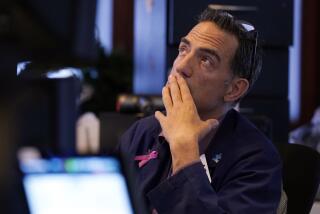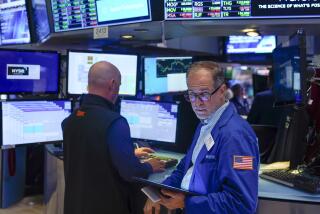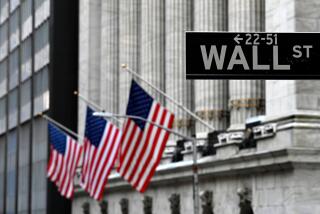Dividend Seekers Can Fare Better in a Volatile Market Like This One
- Share via
What did we learn last week?
Despite four consecutive “up” days for the Dow Jones industrial average, volatility still persists in the stock market. Just look at Thursday’s 216-point drop in the blue-chip index.
And what did we learn last month, the 10th-worst month for stocks dating back to 1926?
One lesson that may be missed by a generation of investors who’ve gotten fat off technology stocks: Dividends matter, especially during volatile periods in the stock market.
Consider the mutual funds that held up best in August.
Throw out the so-called “bear funds,” which are supposed to move in the exact opposite direction of the stock market, and the top-performing domestic equity funds in August were not high-fliers like Janus Twenty or Marsico Focus, which each fell more than 15%. (That’s slightly more than the benchmark Standard & Poor’s 500 index of blue-chip stocks dropped in August.)
The top domestic stock funds in August include funds that lost value but had dividends to minimize the damage--names like Merrill Lynch Strategic Dividend Fund, with a 12-month yield of 2.51%; T. Rowe Price Equity-Income, sporting a 2.52% yield; and Franklin Equity Income I, with a dividend yield of 3.4%.
*
Granted, these are nothing like the 6% or 7% yields that investors used to get from S&P; 500 stocks a generation ago. But they are substantially higher than the S&P;’s meager 1.6% current yield and the 0.6% yield on the typical domestic equity fund.
Break the numbers down further and the argument gets even stronger.
According to fund rater Morningstar Inc., the typical domestic equity fund with a yield of 2% or less lost 16.7% in August and is down 10.28% for the year through the end of August. By comparison, the typical domestic stock fund with a yield between 2% and 3% fell 11.2% in August and is down 6.41% for the year. And funds with yields between 3% and 4% have fallen even less. They’re down 10% for the month and 6.37% for the year.
“When the market is going up continuously, as it has for the past few years, investors are willing to look past dividends because they’re getting rewarded by capital gains,” said Geraldine Weiss, editor of the Investment Quality Trends newsletter in La Jolla. “However, when the market is going down, investors get religion,” said Weiss, author of “Dividends Don’t Lie” and co-author of “The Dividend Connection: How Dividends Create Value in the Stock Market.” “They return to fundamentals. They look for stocks that pay steady dividends, raise dividends, since that provides a floor or safety net under the stock,” she said.
John Snyder, lead manager of the John Hancock Sovereign Investors Fund, which fell 25% less than the S&P; 500 in August, identifies another advantage to investing in funds that invest in stocks that pay high dividends, or those that consistently raise their dividends: “Companies with increasing dividends also tend to have very predictable earnings.”
They have to, to be able to meet and raise dividends out of their cash flow.
*
Consistency of earnings is a tremendous asset in this market, as stalwart companies like Procter & Gamble (now yielding 1.7%) and Gillette (1.4%) have seen their shares get shelled in recent days in the wake of earnings warnings.
The reason investors should search out high-dividend stock funds, then, isn’t necessarily to enjoy the income--because the income is often reinvested in portfolios unless the fund is specifically designed to pay investors regularly. It’s that dividends serve as a good screen for stable stocks in volatile times.
Even in bull markets, the dividend strategy works.
According to Morningstar, the typical domestic stock fund with a yield of 3% or higher returned 13.5% a year for the last 15 years. That’s 10% better than the return on the typical U.S. stock fund.
A couple of solid no-load funds that invest in dividend payers are T. Rowe Price Dividend Growth (minimum initial investment: $2,500; [800] 638-5660), and Scudder Growth & Income (minimum initial investment: $2,500; [800] 225-2470).
Dividend Growth, managed by William Stromberg, invests only in companies with strong balance sheets that have also raised dividends for at least the last five years.
The simple strategy has led the $1.1-billion fund to post returns of 20.8% a year for the last three years through the end of August. Scudder Growth & Income doesn’t demand that companies raise their dividends. Instead, lead manager Robert Hoffman seeks stocks with a dividend yield at least 20% greater than that of the S&P; 500. Once in the $8.3-billion portfolio, a stock will be automatically kicked out if its yield falls to 75% of the S&P.;
This strategy has led the fund to three-year annualized returns of 17.4% and 10-year annualized returns of 15.5%.
Times staff writer Paul J. Lim can be reached at [email protected].
More to Read
Inside the business of entertainment
The Wide Shot brings you news, analysis and insights on everything from streaming wars to production — and what it all means for the future.
You may occasionally receive promotional content from the Los Angeles Times.










